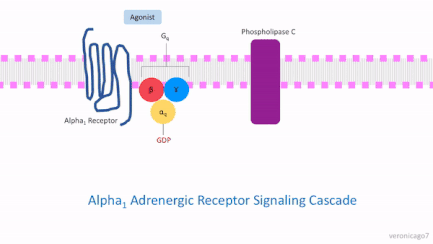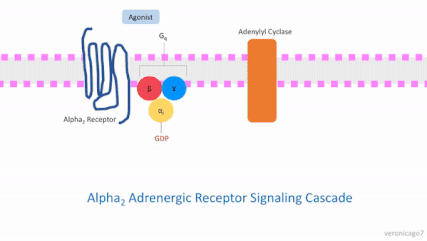Alpha blocker
| Alpha blockers α-blockers | |
|---|---|
| Drug class | |
| Class identifiers | |
| Use | •Hypertension •Vasoconstriction •BPH •Raynaud's Disease •Pheochromocytoma •CHF •Erectile Dysfunction |
| Mechanism of action | •Receptor antagonist •Inverse agonist •Neutral antagonist |
| Biological target | α-adrenoceptors |
| Legal status | |
| In Wikidata | |

Alpha-blockers,also known asα-blockersorα-adrenoreceptor antagonists,are a class ofpharmacological agentsthat act asantagonistsonα-adrenergic receptors(α-adrenoceptors).[2]
Historically, Alpha -blockers were used as a tool for pharmacologic research to develop a greater understanding of the autonomic nervous system. Using Alpha blockers, scientists began characterizing arterial blood pressure and central vasomotor control in the autonomic nervous system.[3]Today, they can be used as clinical treatments for a limited number of diseases.[2]
Alpha blockers can treat a small range of diseases such ashypertension,Raynaud's disease,benign prostatic hyperplasia(BPH) anderectile dysfunction.[2]Generally speaking, these treatments function by binding an α-blocker to α receptors in the arteries and smooth muscle. Ultimately, depending on the type of Alpha receptor, this relaxes the smooth muscle or blood vessels, which increases fluid flow in these entities.[2]
Classification[edit]

When the term "Alpha blocker" is used without further qualification, it can refer to anα1blocker, anα2blocker, a nonselective blocker (bothα1andα2activity), or anαblocker with some β activity.[2]However, the most common type of Alpha blocker is usually anα1blocker.
Non-selective α-adrenergic receptor antagonists include:
Selective α1-adrenergic receptor antagonists include:
Selective α2-adrenergic receptor antagonists include:
Finally, the agentscarvedilolandlabetalolare both α andβ-blockers.
Below are some of the most common drugs used in the clinic.
| Drug Name | Common Brands | Structure | Mechanism of Action | Effects | Clinical Applications | Toxicity |
|---|---|---|---|---|---|---|
| Phenoxybenzamine | Dibenzyline | 
|
Nonselective covalent binding to α1and α2receptors. | Lowers blood pressure by decreasing peripheral resistance.
Blocks Alpha induced vasconstriction.[2] |
|
|
| Phentolamine | Regitine | 
|
Competitive blocking of α1and α2receptors. | Reversal of epinephrine induced effects.
Lowers blood pressure by decreasing peripheral resistance.[2][10] |
| |
| Prazosin | Minipress | 
|
Competitive blocking of α1receptor.[10] | Lowers blood pressure.[2] | ||
| Doxazosin | Cardura
Cardura XL |

|
Competitive blocking of α1receptor.[10] | Lowers blood pressure.[2] |
|
|
| Terazosin | Hytrin | 
|
Competitive blocking of α1receptor.[10] | Lowers blood pressure.[2] | ||
| Tamsulosin | Flomax | 
|
A blocker that has slight selectivity for α1receptors.[2] | Relaxation of prostatic smooth muscle.[2] |
| |
| Yohimbine | Yocon | 
|
Blocks α2receptor, and increases norepinephrine release, thus increasing CNS activity.[2] | Raises blood pressure and heart rate.[2] |
| |
| Labetalol | Trandate | 
|
Blocks some α1receptor activity, but binds more strongly to β receptors.[2] | Lowers blood pressure, increases heart rate slightly.[2] |
| |
| Carvedilol | Coreg
Coreg CR |

|
Blocks some α1receptor activity, but binds more strongly to β receptors.[2] | Can interfere with noradrenergic mechanisms.[2] |
|
Medical uses[edit]
While there are limited clinical α-blocker uses, in which most α-blockers are used forhypertensionorbenign prostatic hyperplasia,α-blockers can be used to treat a few other diseases, such asRaynaud's disease,congestive heart failure(CHF),pheochromocytoma,anderectile dysfunction.[15][16][17]
Furthermore, α-blockers can occasionally be used to treat anxiety and panic disorders, such asposttraumatic stress disorder(PTSD) inducednightmares.[6]Studies have also had great medical interest in testing Alpha blockers, specifically α2blockers, to treattype II diabetesandpsychiatric depression.[2]
Hypertension[edit]
Hypertensionis due to an increase in vascular resistance and vasoconstriction. Using α1selective antagonists, such asprazosin,has been efficacious in treating mild to moderate hypertension. This is because they can decrease vascular resistance and decrease pressure.[2][18]However, while these drugs are generally well tolerated, they have the potential to produce side effects such as orthostatic hypotension and dizziness.[2]However, unlike other treatments for hypertension such asACE inhibitors,ARBs,calcium channel blockers,thiazide diureticsorbeta blockers,Alpha blockers have not demonstrated the same mortality and morbidity benefits, and are therefore not generally used as first or even second line agents.
Another treatment for hypertension is using drugs that have both α1blocking activity, as well as nonselective β activity, such asLabetalolorcarvedilol.[19]In low doses, labetalol and carvedilol can decrease the peripheral resistance and block the effects of isoprenaline to reduce hypertensive symptoms.[19]
Pheochromocytoma[edit]

Pheochromocytomais a disease in which a catecholamine secreting tumor develops.[2][20]Specifically, norepinephrine and epinephrine are secreted by these tumors, either continuously or intermittently.[21]The excess release of these catecholamines increases central nervous system stimulation, thus causing blood vessels to increase in vascular resistance, and ultimately giving rise to hypertension.[20]In addition, patients with these rare tumors are often subject to headaches, heart palpitations, and increased sweating.[2]
Phenoxybenzamine,a nonselective α1and α2blocker, has been used to treat pheochromocytoma.[21]This drug blocks the activity of epinephrine and norepinephrine by antagonizing the Alpha receptors, thus decreasing vascular resistance, increasing vasodilation, and decreasing blood pressure overall.[21]
Congestive heart failure[edit]
Blockers that have both the ability to block both α and β receptors, such ascarvedilol,bucindolol,andlabetalol,have the ability to mitigate the symptoms incongestive heart failure.[22]By binding to both the α and β receptors, these drugs can decrease the cardiac output and stimulate the dilation of blood vessels to promote a reduction in blood pressure.[22]
Erectile dysfunction[edit]
Yohimbine,an α2blocker derived from the bark of thePausinystalia johimbetree, has been tested to increase libido and treat erectile dysfunction. The proposed mechanism for yohimbine is blockade of the adrenergic receptors that are associated withneurotransmittersinhibition, includingdopamineandnitric oxide,and thus aiding with penile erection and libido.[23]By doing so, they can alter the blood flow in the penis to aid in achieving an erection. However, some side effects can occur, such aspalpitation,tremor,elevated blood pressure,andanxiety.[23] Yohimbe barkcontains both α1and α2adrenergic receptorsblockingalkaloids.
Phentolamine,a non-selective Alpha blocker, has also been tested to treat erectile dysfunction. By reducing vasoconstriction in the penis, there appears to be increased blood flow that aids in penile erection. Side effects associated with phentolamine include headache, flushing, and nasal congestion.[23]

Phenoxybenzamine,a non-competitive α1and α2blocker was used by Dr.Giles Brindleyin the first intracavernosal pharmacotherapy for erectile dysfunction.[24]
Benign prostatic hyperplasia[edit]
Inbenign prostatic hyperplasia(BPH), men experience urinary obstruction and are unable to urinate, thus leading to urinary retention.[2]α1specific blockers have been used to relax the smooth muscle in the bladder and enlarged prostate.[25]Prazosin,doxazosin,andterazosinhave been particularly useful for patients with BPH, especially in patients with hypertension.[2]In such patients, these drugs can treat both conditions at the same time.[2]In patients without hypertension,tamsulosincan be used, as it has the ability to relax the bladder and prostate smooth muscle without causing major changes in blood pressure.[25]
Raynaud's disease[edit]

Both α1blockers and α2blockers have been examined to treatRaynaud's disease.Although α1blockers, such asprazosin,have appeared to give slight improvement for the sclerotic symptoms of Raynaud's disease, there are many side effects that occur while taking this drug. Conversely, α2blockers, such as yohimbine, appear to provide significant improvement of the sclerotic symptoms in Raynaud's Disease without excessive side effects.[26]
Post traumatic stress disorder[edit]
Patients withposttraumatic stress disorder(PTSD) have often continued to be symptomatic despite being treated with PTSD-specific drugs.[27]In addition, PTSD patients often have debilitating nightmares that continue, despite their treatments.[27]High doses of the α1blocker,prazosin,have been efficacious in treating patients with PTSD induced nightmares due to its ability to block the effects of norepinephrine.[27]
Adverse effects of prazosin to treat PTSD nightmares includedizziness,first dose effect(a sudden loss of consciousness),weakness,nausea,andfatigue.[27]
Adverse effects[edit]
Although Alpha blockers have the ability to reduce some disease pathology, there are some side effects that come with these Alpha blockers.[28]However, because there are several structural compositions that make each Alpha blocker different, the side effects are different for each drug. Side effects that arise when taking Alpha blockers can include thefirst dose effect,cardiovascular side effects, genitourinary side effects, as well as other side effects.[28]
First dose effect[edit]
One of the most common side effects with Alpha blockers is thefirst dose effect.[29]This is a phenomenon in which patients with hypertension take an Alpha blocker for the first time, and suddenly experience an intense decrease in blood pressure. Ultimately, this gives rise toorthostatic hypotension,dizziness,and a sudden loss of consciousness due to the drastic drop in blood pressure.[29]
Alpha blockers that possess these side effects includeprazosin,doxazosin,andterazosin.[30]
Cardiovascular side effects[edit]
There are some Alpha blockers that can give rise to changes in the cardiovascular system, such as the induction of reflex tachycardia, orthostatic hypotension, or heart palpitations via alterations of the QT interval.[28][31]
Alpha blockers that may have these side effects includeyohimbine,phenoxybenzamine,andphentolamine.[2]
Genitourinary side effects[edit]
When Alpha blockers are used to treat BPH, it causes vasodilation of blood vessels on the bladder and the prostate, thus increasing urination in general.[32]However, these Alpha blockers can produce the exact opposite side effect, in whichedema,or abnormal fluid retention, occurs.[33]
In addition, due to the relaxation of the prostate smooth muscle, another side effect that arises in men being treated for BPH is impotence, as well as the inability to ejaculate.[32][34]However, if any ejaculation activity does occur, oftentimes, it results in a phenomenon calledretrograde ejaculation,in which semen flows into the urinary bladder instead of exiting through the urethra.[34]
Drugs that may produce such side effects includeprazosin,terazosin,tamsulosin,anddoxazosin.[34]
Other side effects[edit]
Finally, there are other general side effects that can be caused by most Alpha blockers (however, more frequently in Alpha -1 blockers). Such side effects includedizziness,drowsiness,weakness,fatigue,psychiatricdepression,anddry mouth.[28][34]
Priapism, an unwanted, painful long term erection not brought on by sexual arousal and lasting several hours has been associated with Alpha blocker use. While this is extremely rare, particularly with tamsulosin, it can cause permanent impotence if not treated in a hospital setting. Male patients should be made aware of this as it can result from a single dose or develop over time.
Contraindications[edit]
There is only one compelling indication for Alpha blockers, which is forbenign prostatic hyperplasia.[33]Patients who need Alpha blockers for BPH, but have a history ofhypotensionorpostural heart failure,should use these drugs with caution, as it may result in an even greater decrease in blood pressure or make heart failure even worse.[35][36]The most compellingcontraindicationisurinary incontinenceand overall fluid retention.[35][36]To combat such fluid retention, patients can take a diuretic in combination with the Alpha -blocker.[36]
In the absence of compelling indications or contraindications, patients should take Alpha blockers as astep 4 therapyto reduce blood pressure, but only if the use of ACE inhibitors, angiotensin-II receptor blockers, calcium channel blockers, or thazide diuretics (in full dose or in combinations) have not been efficacious.[33][35][36]
Drug interactions[edit]
As with any drug, there are drug interactions that can occur with Alpha blockers. For instance, Alpha blockers that are used for the reduction of blood pressure, such asphenoxybenzamineorphentolaminecan have synergy with other drugs that affect smooth muscle, blood vessels, or drugs used forerectile dysfunction(i.e.sildenafil,tamsulosin,etc.). This stimulates exaggeratedhypotension.[2]
Alternative Alpha blockers, such asprazosin,tamsulosin,doxazosin,orterazosincan have adverse interactions withbeta blockers,erectile dysfunctiondrugs,anxiolytics,andantihistamines.[2]Again, these interactions can cause dangeroushypotension.Furthermore, in rare cases, drug interactions can cause irregular, rapid heartbeats or an increase blood pressure.[2]
Yohimbinecan interact withstimulants,hypertensiondrugs,naloxone,andclonidine.Interactions with such drugs can cause either an unintended increase in blood pressure or potentiate an increase in blood pressure.[2]
Finally, in drugs with both Alpha and beta blocking properties, such ascarvedilolandlabetalol,interactions with other Alpha or beta blockers can exaggerate a decrease in blood pressure.[2]Conversely, there are also drug interactions with carvedilol or labetalol in which blood pressure is increased unintentionally (such as with cough and cold medications).[2]Finally, there may also be some Alpha /beta blocker drug interactions that can worsen previous heart failure.[2]
Mechanism of action[edit]
Alpha blockers work by blocking the effect of nerves in the sympathetic nervous system. This is done by binding to the Alpha receptors in smooth muscle or blood vessels.[37]α-blockers can bind both reversibly and irreversibly.[2]
There are several α receptors throughout the body where these drugs can bind. Specifically, α1receptors can be found in most vascular smooth muscle, the pupillary dilator muscle, the heart, the prostate, and pilomotor smooth muscle.[2]On the other hand, α2receptors can be found in platelets, cholinergic nerve terminals, some vascular smooth muscle, postsynaptic CNS neurons, and fat cells.[2]
The structure of α receptors is a classicG protein–coupled receptors(GPCRs) consisting of 7 transmembrane domains, which form three intracellular loops and three extracellular loops.[2]These receptors couple to heterotrimeric G proteins composed of α, β, and γ subunits.[2]Although both of the α receptors are GPCRs, there are large differences in their mechanism of action. Specifically,α1receptorsare characterized as GqGPCRs, signaling throughPhospholipase Cto increaseIP3andDAG,thus increasing the release of calcium. Meanwhile,α2receptorsare labeled as GiGPCRs, which signal throughadenylyl cyclaseto decreasecAMP.[38]
Because the α1and α2receptors have different mechanisms of action, their antagonists also have different effects.[39]α1blockers can inhibit the release ofIP3andDAGto decrease calcium release, thus, decreasing overall signaling. On the other hand, α2blockers prevent the reduction of cAMP, thus leading to an increase in overall signaling.
 |
 |
|---|
See also[edit]
References[edit]
- ^Katzung, Bertram (1987).Basic and Clinical Pharmacology.Appleton & Lange.ISBN9780838505533.
- ^abcdefghijklmnopqrstuvwxyzaaabacadaeafagahaiajakalamanaoapaqarasatauavawaxayazbabbbcKatzung, Bertram; Masters, Susan (2013).Basic and Clinical Pharmacology.Lange.ISBN978-0-07-176402-5.
- ^Bousquet, P.; Schwartz, J. (1983). "Alpha-adrenergic drugs".Biochemical Pharmacology.32(9): 1459–1465.doi:10.1016/0006-2952(83)90466-5.PMID6134533.
- ^McKeage, Kate; Plosker, Greg L. (2002-03-01). "Alfuzosin".Drugs.62(4): 633–653.doi:10.2165/00003495-200262040-00009.ISSN0012-6667.PMID11893233.S2CID250307179.
- ^abNash, D. T. (1990-11-01)."Alpha-adrenergic blockers: Mechanism of action, blood pressure control, and effects on lipoprotein metabolism".Clinical Cardiology.13(11): 764–772.doi:10.1002/clc.4960131104.ISSN1932-8737.PMID1980236.S2CID24619863.
- ^abcGreen, Ben (2014)."Prazosin in the Treatment of PTSD".Journal of Psychiatric Practice.20(4): 253–259.doi:10.1097/01.pra.0000452561.98286.1e.PMID25036580.S2CID40069887.
- ^"Tamsulosin Monograph for Professionals".Drugs.Archivedfrom the original on 2021-01-20.Retrieved29 January2021.
- ^abLepor, Herbert; Henry, David; Laddu, Atul R. (1991-01-01). "The efficacy and safety of terazosin for the treatment of symptomatic BPH".The Prostate.18(4): 345–355.doi:10.1002/pros.2990180408.ISSN1097-0045.PMID1711689.S2CID37160206.
- ^Michel, Martin C. (2010). "The Pharmacological Profile of the α1A-Adrenoceptor Antagonist Silodosin".European Urology Supplements.9(4): 486–490.doi:10.1016/j.eursup.2010.03.006.
- ^abcdefghijklMycek, Mary J.; Harvey, Richard A.; Champe, Pamela C. (1997).Pharmacology(2nd ed.). Philadelphia: Lippincott-Raven.ISBN978-0397515677.OCLC34905985.
- ^Narayan, Perinchery; Tunuguntla, Hari Siva Gurunadha Rao (2005)."Long-Term Efficacy and Safety of Tamsulosin for Benign Prostatic Hyperplasia".Reviews in Urology.7(Suppl 4): S42–S48.ISSN1523-6161.PMC1477608.PMID16986054.
- ^Charney, D. S.; Woods, S. W.; Goodman, W. K.; Heninger, G. R. (1987-08-01). "Neurobiological mechanisms of panic anxiety: biochemical and behavioral correlates of yohimbine-induced panic attacks".American Journal of Psychiatry.144(8): 1030–1036.doi:10.1176/ajp.144.8.1030.ISSN0002-953X.PMID3037926.
- ^Richards, DA (August 1976). "Pharmacological effects of labetalol in man".British Journal of Clinical Pharmacology.3(4 Suppl 3): 721–3.PMID10949.
- ^Cohn, Jay N.; Fowler, Michael B.; Bristow, Michael R.; Colucci, Wilson S.; Gilbert, Edward M.; Kinhal, Vithal; Krueger, Steven K.; Lejemtel, Thierry; Narahara, Kenneth A. (1997)."Safety and efficacy of carvedilol in severe heart failure".Journal of Cardiac Failure.3(3): 173–179.doi:10.1016/s1071-9164(97)90013-0.PMID9330125.
- ^Roehrborn, Claus; Schwinn, Debra (March 2004). "α1-Adrenergic Receptors and Their Inhibitors in Lower Urinary Tract Symptoms and Benign Prostatic Hyperplasia".The Journal of Urology.171(3): 1029–1035.doi:10.1097/01.ju.0000097026.43866.cc.PMID14767264.
- ^Messerli, Franz (November 1, 2001)."Doxazosin and congestive heart failure".Journal of the American College of Cardiology.38(5): 1295–1296.doi:10.1016/s0735-1097(01)01534-0.PMID11691497.
- ^Ernst, E.; Pittler, M.H. (1998). "Yohimbe for Erectile Dysfunction: A Systematic Review and Meta-Analysis of Randomized Clinical Trials".The Journal of Urology.159(2): 433–436.doi:10.1016/s0022-5347(01)63942-9.PMID9649257.
- ^Laurent, Stéphane (2017). "Antihypertensive drugs".Pharmacological Research.124:116–125.doi:10.1016/j.phrs.2017.07.026.PMID28780421.S2CID251991.
- ^abBrogden, R. N.; Heel, R. C.; Speight, T. M.; Avery, G. S. (1978-04-01). "Labetalol: A Review of its Pharmacology and Therapeutic Use in Hypertension".Drugs.15(4): 251–270.doi:10.2165/00003495-197815040-00002.ISSN0012-6667.PMID25757.S2CID42161040.
- ^abBravo, Emmanuel L. (2002-09-01). "Pheochromocytoma".Annals of the New York Academy of Sciences.970(1): 1–10.Bibcode:2002NYASA.970....1B.doi:10.1111/j.1749-6632.2002.tb04408.x.ISSN1749-6632.PMID12381537.S2CID222084372.
- ^abcDas, Sambhunath; Kumar, Pankaj; Kiran, Usha; Airan, Balram (2017-01-01)."Alpha blockers: A relook at phenoxybenzamine".Journal of the Practice of Cardiovascular Sciences.3(1): 11.doi:10.4103/jpcs.jpcs_42_16.
- ^abBristow, Michael R. (2000-02-08)."β-Adrenergic Receptor Blockade in Chronic Heart Failure".Circulation.101(5): 558–569.doi:10.1161/01.CIR.101.5.558.ISSN0009-7322.PMID10662755.
- ^abcLue, Tom F. (2009-08-20). "Erectile Dysfunction".New England Journal of Medicine.342(24): 1802–1813.doi:10.1056/nejm200006153422407.PMID10853004.
- ^Carson, Culley C., ed. (2007),"A Description of the Pioneering Work That Led to the First Approved Agents for ED: Giles Brindley, the Needle, and the Penis (Phenoxybenzamine)",Key Clinical Trials in Erectile Dysfunction,London: Springer, pp. 4–7,doi:10.1007/978-1-84628-428-1_2,ISBN978-1-84628-428-1,retrieved2024-02-26
- ^abChapple, CR (January 1996). "Selective Alpha 1-adrenoceptor antagonists in benign prostatic hyperplasia: rationale and clinical experience".European Urology.29(2): 129–144.PMID8647139.
- ^Bakst, Richard; Merola, Joseph F.; Franks, Andrew G.; Sanchez, Miguel (2008). "Raynaud's phenomenon: Pathogenesis and management".Journal of the American Academy of Dermatology.59(4): 633–653.doi:10.1016/j.jaad.2008.06.004.PMID18656283.
- ^abcdKoola, Maju Mathew; Varghese, Sajoy P.; Fawcett, Jan A. (2013-08-16)."High-dose prazosin for the treatment of post-traumatic stress disorder".Therapeutic Advances in Psychopharmacology.4(1): 43–47.doi:10.1177/2045125313500982.PMC3896131.PMID24490030.
- ^abcdManning, Loretta; Rayfield, Sylvia.Pharmacology Made Easy.Bossier City, LA: ICAN. p. 38.
- ^abHodsman, G.P (12 March 1983)."Factors related to first dose hypotensive effect".British Medical Journal.286(6368): 832–834.doi:10.1136/bmj.286.6368.832.PMC1547159.PMID6403103.
- ^Elliott, Henry L. (2007). "Alpha Adrenoreceptor Antagonists".Comprehensive Hypertension.pp. 1019–1025.doi:10.1016/b978-0-323-03961-1.50085-4.ISBN9780323039611.
- ^Lepor, Herbert; Lepor, Norman (Spring 2008)."The QT Interval and Selection of Alpha-Blockers for Benign Prostatic Hyperplasia".Reviews in Urology.10(2): 85–91.PMC2483321.PMID18660858.
- ^abLepor, Herbert (Fall 2007)."Alpha Blockers for the Treatment of Benign Prostatic Hyperplasia".Reviews in Urology.9(4): 181–190.PMC2213889.PMID18231614.
- ^abc"Alpha-blockers: their properties and use in hypertension".Prescriber.22(13–14): 38–39. July 2011.doi:10.1002/psb.779.
- ^abcdDebruyne, Frans M.J. (2000). "Alpha blockers: are all created equal?".Urology.56(5): 20–22.doi:10.1016/s0090-4295(00)00744-5.PMID11074198.
- ^abc"Alpha-Adrenoceptor Antagonists (Alpha-Blockers)"(PDF).British Hypertension Society.Archived fromthe original(PDF)on 2017-08-29.
- ^abcd"CV Pharmacology | Alpha-Adrenoceptor Antagonists (Alpha-Blockers)".cvpharmacology.Retrieved2017-11-15.
- ^Knott, Laurence (2015-06-27)."Alpha-blockers".Patient.
- ^Pierce, Kristen L.; Premont, Richard T.; Lefkowitz, Robert J. (2002-09-01). "Signalling: Seven-transmembrane receptors".Nature Reviews Molecular Cell Biology.3(9): 639–650.doi:10.1038/nrm908.ISSN1471-0080.PMID12209124.S2CID23659116.
- ^Bylund, D.B. (February 1, 1992)."Subtypes of Alpha 1- and Alpha 2-adrenergic receptors".The FASEB Journal.6(3): 832–839.doi:10.1096/fasebj.6.3.1346768.PMID1346768.S2CID83827013.
